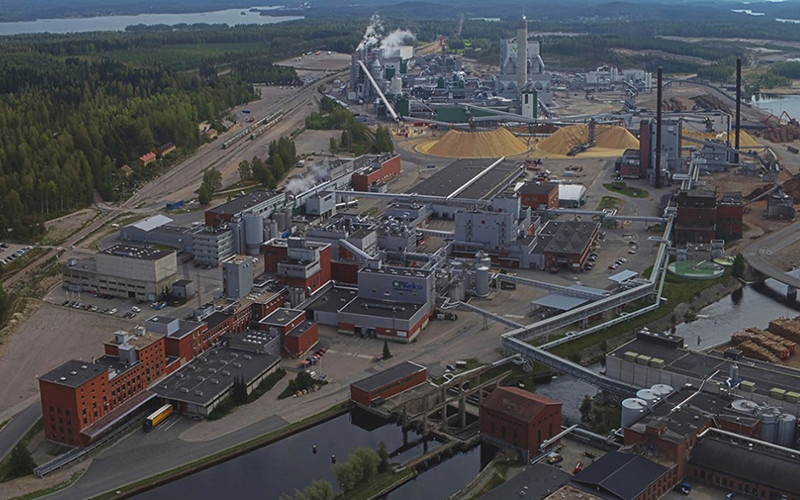
by Dianna Brodine, editor, PostPress
To answer calls by brands and consumers alike for sustainable and innovative packaging, Metsä Board has created an Excellence Centre in Äänekoski, Finland. The 1,500-square-meter building houses 30 employees and contains technology for research and development in both packaging design and performance, providing a collaboration platform for customers and technology partners globally, according to the company.
In a recent media event, Metsä Board offered a virtual tour of the new Excellence Centre and answered some questions about its investment in sustainability. The company has a reputation as Europe’s leading producer of folding box board, and growth has been healthy in the United States – driven by sustainability issues in the marketplace. It strives to create packaging solutions that respect nature – not just through its paperboard and liner products, but also via the services offered to customers. With the packaging industry facing a variety of challenges driven by the consumer – including excess packaging waste, reducing harmful chemicals in packaging and the reduction of single-use plastics – aggressive legislation is placing pressure on brand owners to increase their commitments to sustainability.
The excellence center is an active collaborative environment for research and testing. “It’s a functional place for innovation, co-creation and creative ideas,” said Marko Leiviskä, graphic packaging designer. “We need to speed up innovation because of growing consumption and a pressing need to reduce the use of plastic.”
Mark Beamesderfer, packaging services director, Metsä Board Americas, continued: “We are working to create more environmentally friendly and efficient fiber board packaging. Packages are often overengineered. We believe in simplifying packaging to create an easy user experience, and fiber reduction is inherent to Metsa’s lightweight paperboard.”
The centre offers package design services from analysis and improvements to current packages to design concepts and physical mockups, using conventional equipment or 3D printers. The research lab provides testing of a variety of factors, including barrier solutions, converting efficiency, product safety and performance simulations. And finishing isn’t neglected – the site contains a gluing device for water-based adhesives or hot melts to test glues used on packaging lines.
Onsite packaging-related consumer behavior assessment capabilities in a simulated retail environment allow for immediate testing of concepts. “When you think of branding, the packaging is a powerful tool for setting the level of branding and perception of value,” said Leiviskä. ”How does it compare to rivals? Putting those brands on the same shelves is one way to study shelf appeal.”
Leiviskä and Beamesderfer answered questions following the event.
Q: Why are sustainability and the circular economy so important to Metsä Board?
Beamesderfer: Sustainability is a longstanding mindset that concerns everybody at Metsä, as each of us plays a role in contributing to our strategic 2030 sustainability objectives.
Leiviskä: We see great value with regard to the circular economy by keeping resources in the cycle and being highly resource efficient. Resource efficiency is the foundation of sustainable and economical operations. We use raw materials, energy and water as efficiently as possible. In addition, being a forerunner in sustainability creates a competitive advantage. For example, improving energy efficiency creates cost savings.
Q: Among the variety of onsite equipment at the Excellence Center, what types of equipment is available for package design mock-ups?
Leiviskä: At the Excellence Center we have a printer and a plotter to create printed mock-ups. When it comes to embossing and hot foiling, those are tested with trusted converter partners in order to get an outside opinion about how paperboard works. Often these techniques require such deep knowledge and understanding on converting techniques and on specific machinery – or foil used – that only a professional can handle.
Q: In Metsä’s experience, what types of packaging decoration receive the most attention when studying eye tracking results?
Beamesderfer: What causes packages to get attention on the store shelf is effective packaging design combining both structural and graphical elements to differentiate the package from its competitors.
Leiviskä: It depends heavily on what kind of product group we are working with – cosmetics and cereals are very different from each other. Also, the consumer sets their own standards on packaging. Some product groups are more down to earth – and some more luxurious. We need to keep this in mind – for example, adding hot foil to the wrong category would not necessarily add to the sales – but it would add to the cost. Adding hits on eye tracking also is affected by the placement on shelf, so we are painting a very big picture.
For more information on the Excellence Centre, visit www.metsaboard.com.

